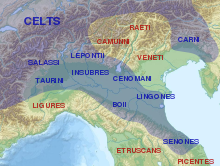Senones
Part of the Senones settled in the Italian peninsula, where they ousted the Umbrians between Ariminum (modern-day Rimini) and Ancona.
[8][9] The Gaulish ethnonym Senones is generally interpreted as meaning 'the ancient ones', by deriving the name from the Proto-Celtic root *sen- ('old'; cf.
[13] The city of Sens, attested in the 4th century AD as Senonas oppidum ('oppidum of the Senones'), is named after the Gallic tribe.
[14][15] The Senones of Gauls dwelled around their capital Agedincum (present-day Sens), which Caesar referred to as an urbs in mid-first century BC, a term suggesting a genuine city rather than a mere settlement.
Over the first centuries AD, the city's name remained in use, and inscriptions attest to its role as the civic capital.
[15] Their territory, whose exact boundaries have been much discussed, broadly corresponded to the ancient regions of Sénonais, Gâtinais, Melunois, Stampois, southern Brie, and Provinois.
Over time, parts of this territory separated to form new cities, notably that of the Tricasses, in the area of modern Troyes.
The praetor Caecilius was sent with an army to avenge their murder but he was killed by the Etruscans and Gauls, together with 7 military and many nobles.
[17][obsolete source] A branch of the Senones (or a different tribe of the same name) settling the district which now includes the departments of Seine-et-Marne, Loiret and Yonne from 53–51 BC were engaged in hostilities with Julius Caesar brought about by their expulsion of Cavarinus, whom he had appointed their king.


